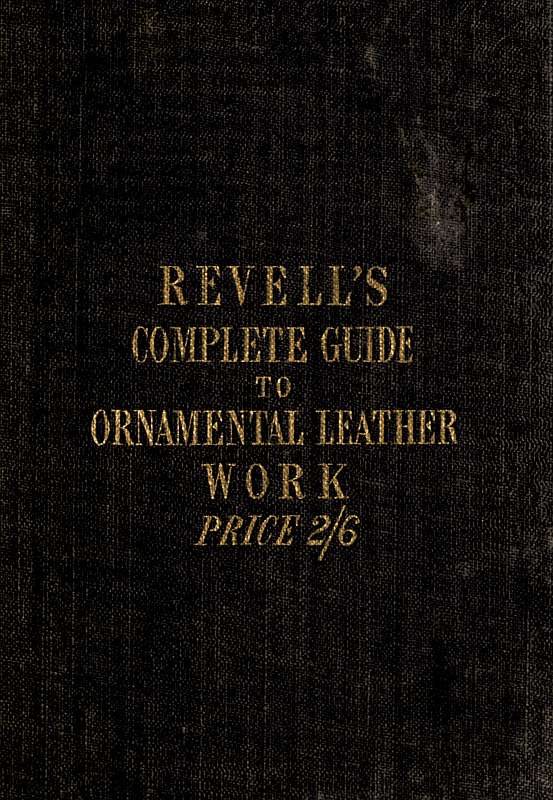
The Project Gutenberg EBook of A Complete Guide to the Ornamental Leather Work, by James Revell This eBook is for the use of anyone anywhere at no cost and with almost no restrictions whatsoever. You may copy it, give it away or re-use it under the terms of the Project Gutenberg License included with this eBook or online at www.gutenberg.org Title: A Complete Guide to the Ornamental Leather Work Author: James Revell Release Date: January 27, 2013 [EBook #41927] Language: English Character set encoding: UTF-8 *** START OF THIS PROJECT GUTENBERG EBOOK GUIDE TO ORNAMENTAL LEATHERWORK *** Produced by Chris Curnow, Rosanna Murphy and the Online Distributed Proofreading Team at http://www.pgdp.net (This file was produced from images generously made available by The Internet Archive)
Transcriber’s Notes:
Spelling has been retained as it appears in the original publication except as marked like this in the text. The original text appears when hovering the cursor over the marked text. A list of amendments is at the end of the text.

[ix]

We feel assured that a long introduction is neither requisite to the reader or publisher of a Work like the present, and shall, therefore, merely say, that the great success our former little Works have met with,[x] has induced us to send forth this edition, in which will be found every particular connected with this very useful source of amusement and fashionable department of practical art. The illustrations are furnished by a late pupil of the School of Design, who obtained the highest prize for Flower Painting, assisted by a student of the Royal Academy of Arts. Every example given has been practically tested, and, in most instances, the drawings have been copied from the models executed in leather, and will be found to combine durability with beauty of design. In order to make the leather modelling as durable as possible, we have not departed from nature in the finished form, but in the mode of construction; for example, we make several portions of a flower in one piece of leather. The Narcissus and the beautiful White Lily have each six petals; in both instances, we make the entire corolla of the flowers in one piece; thereby, while losing none of the beauty of the natural form of the flowers, we gain strength and solidity; as, were the petals of the Lily or Narcissus to be composed of six pieces, one, if imperfectly cemented, might fall off and[xi] detract from the beauty of the entire piece of work. By our method of proceeding, it is impossible to do so: we mention this, as, in our description of Making and Modelling Flowers in Leather, we differ from the literally botanic construction, while, at the same time, we arrive at perfectly correct and artistic formation.
In some flowers, as in the Hop, Dahlia, &c., we have found it impracticable to combine many petals in one piece of leather; where this is the case, especial care must be taken to have good liquid glue, and fasten each petal securely.
All leather to be used in Modelling Leaves, Flowers, &c., must be first wetted, and modelled while wet; and as this is a general rule, the student will understand that mention of the necessity of this operation will not in every instance be repeated.
Amongst the many uses to which Leather Work is applied, that of ornamenting Pulpits will be found a capital field for the display of this art, as it is capable of[xii] being moulded into any form, and nothing can possibly have a more substantial and beautiful appearance.
Glasses of varied form, as jelly glasses and old-fashioned goblets, as well as many of modern manufacture, can be covered on the outside with Leather Work. Lilies of the Valley, and other such flowers, being trailed round a groundwork of leaves, and being either gilded or stained, look exceedingly well; and as they are capable of holding water, become really useful as well as ornamental articles for bouquets of flowers.
Fire-screens and scroll work are executed exactly in the same manner, as described in the following pages, for frames. Fire-screens are generally filled with Berlin wool, or some other fancy work. Those who would prefer to have an entire piece of Leather Work, can paint landscapes or flowers upon white leather, using the same medium which is used at the School of Design for body colour painting, mixed with finely powdered colours.
[xiii]
Gold Leather Work looks remarkably well upon a blue or crimson velvet ground, and makes very rich frames, fire screens, &c. When tastefully arranged, the flowers and leaves upon these grounds have a very magnificent appearance.
Amongst the numerous articles which admit of being ornamented with leather, may be enumerated frames, brackets, vases, pole and hand screens, card plates and racks, music and watch stands.
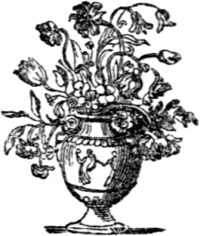
[15]

The principal Materials required for this work are—
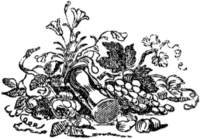
[17]
The kind of leather used for general purposes is basil; it should be selected of an even texture and of a light colour, as the lighter coloured basil takes the oak varnish stain better than the dark.
Great care must be taken to select it soft and free from blemishes, as if dark and rough leather is used, the work when finished, even by skilful hands, will not have so good an appearance as the production of much less skilful artists, where good basil leather is used.
The skiver leather is used for making grapes, or very small leaves and flowers, and can be obtained at the same place as the basil leather; this kind is also very useful for thin stems and any minute portion of the work.
[18]
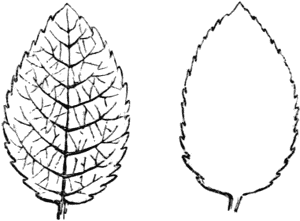 No. 1.
No. 1.
Sketch, either from nature, or from the example annexed, the leaf you intend to copy, upon pasteboard; cut it out very carefully; then place a piece of basil in cold water for half a minute (not longer), unless the leather is unusually thick; the leather should then be taken out of the water, and pressed in a linen cloth until the surface becomes dry. Being thus prepared, lay it quite flat and place upon it the pasteboard pattern,[19] holding it firmly down with the left hand, while with the right, draw a line round the pattern with a fine hard black lead pencil or the veining tool: while the leather is damp cut out the leaf with a pair of scissors or with the leather-cutting knife, as occasion may require; when smaller or larger leaves are required, a reduced, or enlarged, sketch should be taken, a pattern made of it in pasteboard, and applied in the same manner as described above, cutting out as many leaves as you require, and generally making about four sizes of them, as varying the sizes of the leaves adds much to the beauty of the foliage. Leaves all the same size would have a very formal appearance, as they must be veined before they are allowed to dry; too much leather must not be wetted at a time, nor more leaves cut out than can be veined. To vein the leaves, mark them with the veining tool on the smooth side of the leather strongly, by pressing heavily on the leaf, where a thick vein is required; and more lightly where only finer ones should be visible; for raised veins employ the end of a fine pair of scissors for the large, and a hard steel pen for the[20] smaller veins. Being veined, the leaves should be bent and moulded as they are to appear upon the work when it is completed: they should then be dried rather quickly, as it greatly assists in the hardening.
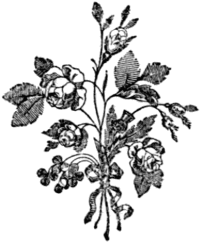
[21]
When the leaves are thoroughly dry, brush them all over, particularly the edges with the prepared stiffening, applying it with a camel’s hair pencil, nimbly, as it dries very rapidly, apply it thin and evenly, taking care to cover the edges; when dry, they will be ready for staining.
[22]
Pour a little oak varnish stain into a small vessel, and brush the leaves all over, using a hog’s-hair tool for the purpose of laying on the stain, taking care to cover the edges, and brush it well out of the veined parts; should the leaves, when dry, not be so dark as desired, another coat can be given, but in no instance apply thick coats of stain, it will, if put on thick, most likely dry darker in one place than another, and will never have so smooth an appearance as when two thin coats have been applied; take care always that one coat must be dry before another is applied.
[23]
Cut strips of basil leather about one-third of an inch wide and as long as the leather will allow; soak them well in water for a few minutes until they feel very soft, take them out, wipe the water from the surface, then roll them round as tightly as possible (the smooth side outwards) on a table or any even surface, and dry them; if required very stiff, add inside a piece of wire; when very thick ones are required the leather must be proportionately wider.
[24]
Tendrils are made in the same manner as Stems, using skiver instead of basil leather, dry them quickly, and they will then be ready for use in the following manner: take a tendril, damp it and immediately wind it round a bradawl or a piece of stout wire, taking care to fasten both ends of the tendril so that it does not fly off; dry it by the fire, then remove it from the awl and a delicately-formed tendril will be the result; arrange it and cut to length and form wished, and apply a coat of stiffening to keep it in shape. Stems and tendrils are to be hardened and stained precisely in the same manner as the leaves.
[25]
In order to produce grapes symmetrically formed a proper mould should be obtained; then cut rounds of skiver leather the size required, which must be wetted and placed in the mould the smooth side downwards; then fill the leather in the mould firmly with wadding, and tie the grapes securely with strong thread or fine twine; when the grape is finished, put a piece of wire through the part where it has been tied up to form a stalk. Or grapes can be made of deal or any soft wood with a hole pierced through the centre large enough to admit of a leather or gutta percha stalk being drawn through and fastened at one end; they should now be stained and made into clusters; wooden grapes may be covered with damp skiver leather if preferred; it is necessary to observe, in making the clusters that the tying should be entirely concealed; all fruit and flowers must be stained, &c., precisely in the same manner as leaves.
[26]
Procure a deal frame of the size and form required, taking care to have it made of well-seasoned wood. Size it all over with patent size. Leave it about an hour to dry, then apply a coating of oak varnish stain, and when dry it will be ready for use. Commence the process of covering by attaching the stem with small tacks all round, in spaces of a few inches, in a zigzag direction. Supposing the vine pattern frame is selected, cover the wood with four or five gradations of foliage, well arranged, so as to preserve as nearly as possible, the natural appearance of the vine. Too great a profusion of grapes should be avoided; but as the number and size of the clusters can hardly be determined, we must therefore leave it to the taste of the artist.
Common pins can be used with advantage in keeping in its proper place that portion of the work where glue[27] only can be applied for the permanent fastening. When the work becomes firmly attached, the pins can either be withdrawn, or they can be cut off, close to the ornaments, with the nippers.
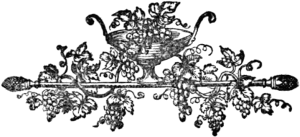
[28]
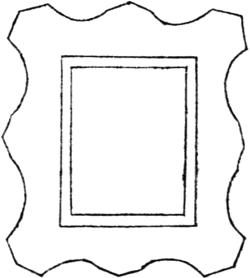 No. 2.
No. 2.
The frames best adapted for the work, we have found to be those levelled off on the outer edge to about half an inch thinner than the inner, and formed as shewn in Fig. 1. Frames made in this shape greatly increase the beauty of the entire design. A narrow gold beading we have generally added inside, as the gold gives a more finished appearance to the frame.
[29]
Can, like one below, be made by every carpenter; they must be strong to bear the nailing and gluing on of the leather ornaments. The design here given (Fig. 2), we keep, as well as other descriptions in stock, but they can[30] be varied ad infinitum; and we shall be happy to make any design to order very promptly, or, as we have before observed, almost any carpenter can make them, if furnished with a drawing to work from.
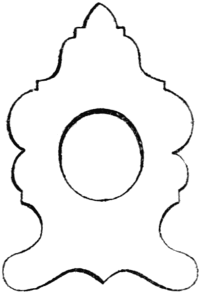 No. 3.
No. 3.
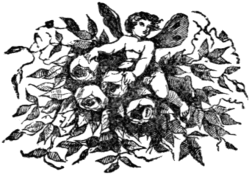
[31]
 No. 4.
No. 4.
This beautiful flower, one of the oldest inhabitants of the flower garden, has six petals, which are formed of one piece of leather, as in Fig. 1; the three largest[32] petals, which, alternate with the others, are brought uppermost, while the three smaller ones are placed behind. Our readers will at once perceive what is meant by referring to the finished flower; they are to be veined and curled as in the natural flower, and the petals will require to be glued to keep them in their proper places; it is necessary, if you have not our mould for that purpose, to adapt something to place the lily upon while modelling it, as near the shape of the interior of the flower as possible. The lily has six stamina, with oblong anthers, which are made in the manner described for the convolvulus; the pistil, with its swollen base or germen, lengthened style and heart-shaped stigma, should be carefully imitated from nature, being a very prominent feature in the flower; the stamina should be placed round the germen of the pistil and fastened with liquid glue into the centre of the flower; it must be recollected that the smooth side of the leather must be inside the lily as in the convolvulus; some flowers require the smooth side of the leather inside, and some outside; it must depend upon whether the interior or[33] exterior of the flower is most in sight, and in some instances in the same flower some petals must be placed one way, and some another.
The bud of the lily is formed by merely folding the whole corolla together veined.

[34]
 No. 5.
No. 5.
The calyx forms the external part of this flower, and is made with one piece of leather cut as in the accompanying (Fig. 1). The petals within this are four, and are cut out, the four in one piece; in the form of the[35] dotted line, in Fig. 1, they must be moulded into shape and glued to the stamina inside the calyx so as to alternate with its petals. This flower belongs to the class Enneandria, having nine stamina; they are to cut in one piece of leather. To put the fuchsia together, proceed as follows:—Cut the nine stamina, and attach to them the wire, to form the stalk; then roll the four petals firmly over the stamina; they must be moulded and glued round the stamina and stalk, then take the calyx and roll round the whole; the leaves must be expanded and moulded as in the engraving, taking care that the stamina are left out as in the natural flower, and that the inner petals alternate with the leaves of the calyx; to make the buds, roll up the calyx, and turn the ends in, not inserting any stamina.
[36]
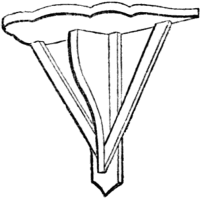 No. 6.
No. 6.
The beauty of a bracket depends entirely upon the artistic skill displayed in ornamenting it. The engraving here given is to illustrate the form of bracket best suited to give it strength and solidity, and to aid the artist in bringing the work well out, the strips of wood on each side of the piece in the centre will be found exceedingly useful to nail and glue the work[37] upon; they must be entirely covered with the foliage; the centre piece can be hidden or not to suit the design; the appearance of brackets are much improved by having the edge of the upper part gilded.

[38]
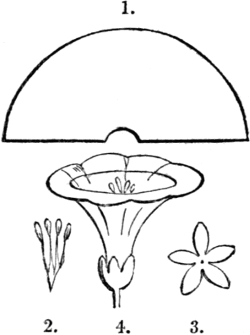 No. 7.
No. 7.
The Convolvulus, termed, by Botanists, Monopetalous, from its being composed of only one petal, is exceedingly well adapted for leather work; it is made by cutting a half circle of leather with a little piece cut out of the centre of the diameter, as seen in the annexed engraving (Fig. 1). The leather so cut must be wetted and veined, then bent round (the smooth side inside, so that the smooth side[39] of the leather form the inside of the flowers) until the two edges on each side of the notch come together, where they are to be joined by being either stitched or glued together; it will then have a conical shape, and must be moulded with the fingers, or the mould, until it assumes a natural appearance; the top can be cut to shape, and that part is finished; cut the stamina, as in (Fig. 2), leaving a stalk of leather attached to it in the following manner:—take a piece of basil about a quarter of an inch wide and a few inches long; cut the top as in Fig. 2, taking care to preserve the form of the anther at the top of each stamen, and rolling the stalk part up, put it through the petal and glue it in its proper place. The calyx has five leaves (Fig. 3), and is cut in one piece of leather; a hole is made in the centre, it is strung on the stalk and attached with glue to the bottom of the flower outside as in the finished flower (Fig. 4), so that the perfect convolvulus is composed of three pieces, the petal forming the body of the flower, the stamina inside, and the calyx at the bottom of the flower outside.
[40]
Another way to make the Convolvulus is to cut a round piece of leather the size of the flower required, and while wet, moulding it over the mould for that purpose and bending it into shape; the Canterbury bell can be formed of one piece of leather in the same manner, cutting the top into proper shape with a pair of scissors.
[41]
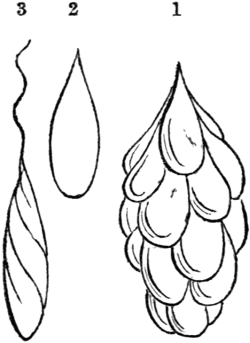 No. 8.
No. 8.
The Hop consists of numerous membraneous scales having the fruit within, and at their base; with the fruit however we have nothing to do, as it is out of sight. The membraneous scales are the petals of the flower, and in the engraving (Fig. 1), are twenty in number; they are all the same size, and are cut out of skiver leather, the shape of the single petal (Fig. 2).
[42]
To make the Hop, proceed as follows:—Take a piece of wire and wind leather round the end of it, as in Fig. 3, fastening it well with liquid glue; this inner body should be somewhat shorter than the Hop is to be when completed, and pointed at both ends. Cut out as many petals as are requisite, and mould them into a convex form at the end of each petal, then glue them alternately, commencing at the bottom and finishing at the top of the flowers.
[43]
The Passion Flower is composed in leather of five pieces, and when well made presents a very beautiful specimen of what can be accomplished in that material.
 No. 9.
No. 9.
In making the Passion Flower cut out the calyx of five leaves—that is the part of the drawing in the annexed diagram with the pointed end; then cut out the[44] corolla of five petals with the rounded ends; cut also a circular piece for the nectary, which must be cut all round with the knife to form the radii, the centre having many small cuts radiating from the central point; when turned upward, in putting it in its place, forms the fringe-like appearance around the pistil seen in the flowers.
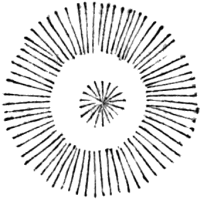 No. 10.
No. 10.
The Passion Flower has five stamina with ladle-shaped ends, or anthers, and three stigmas a little elevated above and turning over the stamina; the anthers and stigma are made of one piece of leather. The involucrum[45] is formed also of one piece, and the three leaves are laid one over the other as in the annexed flower.
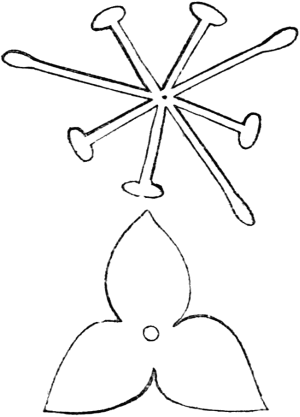 No. 11.
No. 11.
To put together the various parts above described and form the Passion Flower, begin by doubling a piece of wire over the angles of the stamina, twisting it underneath;[46] roll a piece of skiver leather round the wire to form the style of the pistil and the stem of the whole flower; then turn up the three stigmas and roll a small piece of leather round them close to the stamina and turn them over; this being done, place the nectary on the stem, taking care that the cut portion in the centre be arranged upwards around the pistil. The petals are next placed on the stem, followed by the calyx; the leaves of the calyx must alternate with the petals; liquid glue must be inserted between each portion of the flower to give it firmness.
The involucrum, which is a sort of calyx, is put on the stem last a little way below the true calyx; we may just add, that all the leaves, petals, &c., with the exception of the involucrum, must have the smooth side of the leather uppermost; the petals and calyx must be hollowed out with the modelling tool for that purpose, or if that is not at hand, use the handle of the veining tool, and laying the petals and also the calyx on a smooth surface,[47] rub them with the ivory end of the veining tool till they become hollow and smooth as in the natural flower.
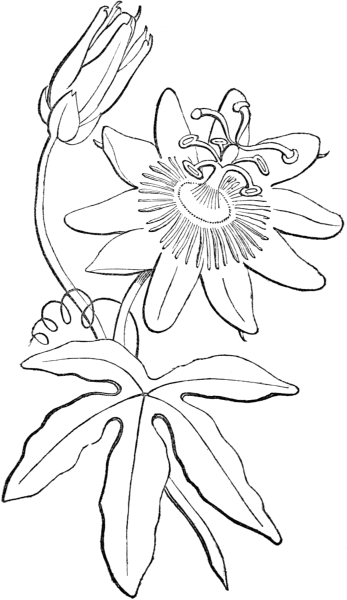 No. 12.
No. 12.
[49]
The above is the way, as plainly as we can possibly describe it, to make a Passion Flower. We have repeatedly made the flower exactly upon the above plan, and it has always been much admired.

[50]
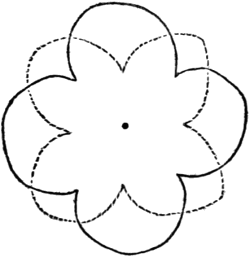 No. 13.
No. 13.
Camillas vary in the form of leaves, and the petals vary in number. To make a camilla, cut out two pieces, as in the annexed diagram, containing four petals in each; then cut out one or two larger pieces, with six petals in each, and one or more still larger, with seven or eight petals; then, having a natural camilla at hand,[51] mould them all into form, fasten all the pieces of leather together, the smallest at the top, and the largest at the bottom, so that the petals alternate, with liquid glue, and put a piece of wire through the whole for the stalk; cover it with skiver leather.

[52]
 No. 14.
No. 14.
To make the Jessamine, copy the corolla from the annexed design, by cutting a star-like piece of basil, into which insert the wire for the stalk as closely as possible. As the stamina are not visible in this flower, it is needless to make them. The tube upon which the corolla rests,[53] can be made by rolling a piece of leather round the wire thickest at the flower, and then add another piece of leather about an inch below the corolla, which must have five fine pointed leaves for the calyx.

[54]
 No. 15.
No. 15.
The Daisy is formed by making two pieces of leather, like the pattern, one larger than the other, and putting the wire, for stalk, through both of them. The little golden centre of the daisy, can be well imitated by[55] placing a round piece of leather, rather thick, in the centre, shaved off at the edges, and marked with the veining tool full of dots.

[56]
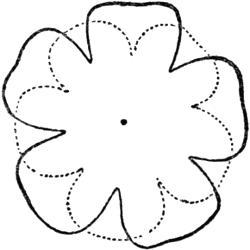 No. 16.
No. 16.
A Wild Rose is made by cutting out two pieces of leather, exactly as in the engraving, putting the wire through two holes made in the centre of the pieces with a fine bradawl, and pass a piece of wire through the holes, leaving both ends of the wire at the back to be twisted for the stalk. To form the stamina, cut fine strips of leather as long again as the stamina are required to be, and insert them under the eye of the wire which[57] forms the stalk; then cut the stamina, and pinch them up into form; the top piece, containing five petals, must be moulded and curved upward, inclosing the stamina; the bottom piece also, containing five petals, must be moulded downwards, curving and bending them into form.
To make a larger Rose, cut out a smaller piece than is shewn in the engraving, of the same form, also the two in the engraving, and a larger piece of the same form making four pieces, containing twenty petals; then proceed as before-mentioned, and a fuller Rose is produced; thus the character of the flower and the number of petals can be regulated with comparative ease.
The rose leaves can be moulded at the back by pressing them into the grape mould with one of the pressing tools.
[58]
 No. 17.
No. 17.
The Bracket annexed is out of the usual run of brackets which have generally been ornamented with leather work. The vine and the convolvulus pattern are much used with very beautiful effect. We intended this design to exhibit old oak: it should be stained very dark, the oak stems being very thick, while the stems of ivy can be formed of tendrils. To make the oak stems[59] get very thick wire, and have it cut to the desired lengths, then cover the wires with leather, and bend them to resemble knarled oak; attach, as naturally as possible, oak leaves and acorns at the back of the wires, and on the wood work as shewn in the skeleton bracket in a former part of this work; then attach the ivy tendrils, leaves, and berries around the oak stems, and the bracket is completed.
We have found it much improves the appearance of any piece of work we have been ornamenting, to give the whole when completed a slight coat of varnish.

[60]
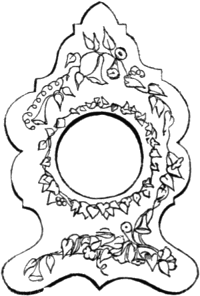 No. 18.
No. 18.
The design for a Watch Stand will illustrate one of the various modes of ornamenting this kind of work; it is very light, and better than too much crowding the ornamented parts, which, besides being a waste of time, would not look so elegant as lighter work.
[61]
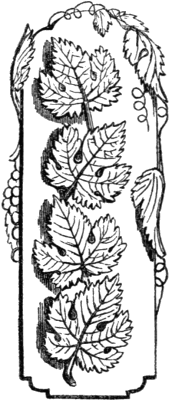 No. 19.
No. 19.
Can be made in a variety of ways—the design here exhibited is novel, and at the same time very useful.[62] The back is made either with wood, or calf-skin leather; and the leaves forming the rack are also made of the same material. Calf-skin dries very hard, being treated exactly the same as the basil leather in the manner of working.

[63]
The beautiful design in the accompanying page is made with a round frame of any width desired, having two rebates, one inside and one outside the frame—the inside rebate being to admit the picture, and the outside one to allow of the nailing firmly to the frame the open work, which is to be made in the following manner:—Take a flat board, an ironing board will do, lay the frame upon it, and with a black lead pencil or a piece of chalk, mark the size all round, making allowance for the rebate; then having ready the stems, work them in and out, so as to form the open work as in the drawing; when finished, nail it to the frame, and work stems and tendrils of the vine, hop, passion flower, or any other beautiful creeping plant, attaching the fruit or flowers in an artistic manner, and the result will be one of the most elegant frames ever beheld.
[64]
The open or trellis work of this frame should have stout wire enclosed in the basil leather, and in order that it may not appear formal, wind pieces of leather round the naked wire at irregular intervals to resemble knots, &c. then cover the whole with basil leather,—the stem and tendrils which are to wind in and out, and are a portion of the plant, are not to have wire in them.
Fire Screens are generally filled with Berlin wool, or some other fancy needlework. Those who would prefer to have an entire piece of leather work can paint landscapes or flowers upon white leather, using the same medium as is used in body colour painting at the School of Design, mixed with finely powdered colours.
[65]
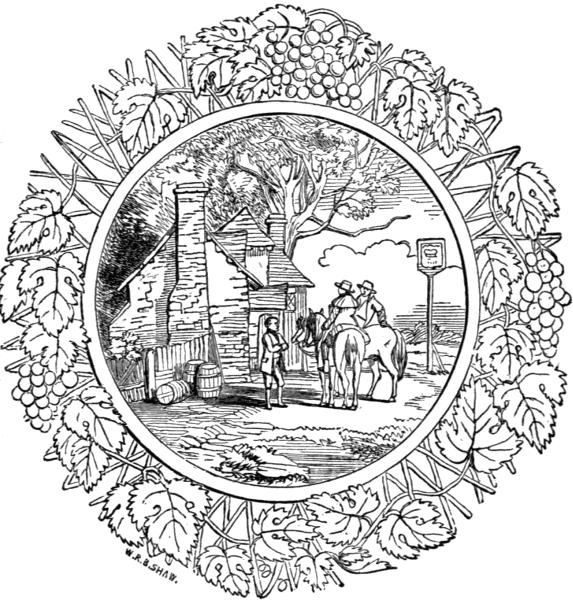 No. 20.
No. 20.
[67]
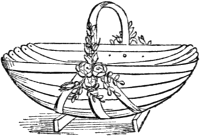 No. 21.
No. 21.
The basket ornamented with rose sprays outside, can be lined inside with velvet, and little pockets being made in the velvet lining, they become a very useful article; the outside is stained old oak.
[68]
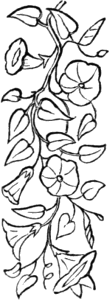 No. 22.
No. 22.
The running border here displayed can be adapted to ornamenting cornices, poles, frames, &c.; it is very easy of imitation, and will well repay the artist.
[69]
We shall conclude our designs with the table, which is made in four pieces, so that one part can be done at a time, and when completed, can be removed until the whole is completed, when it can be put firmly together, and forms a solid example of the use and beauty of the Ornamental Leather Work.
[70]
 No. 23.
No. 23.
[71]
Acorns can be made in the following manner. Procure some natural acorn-cups (which are to be found in great quantities in the autumn), choose such cups only as are perfectly sound; then pierce two holes through the bottom of the cup, pass a piece of fine wire through the holes, leaving the two ends long enough to be twisted into a stalk; if the stalk is to be exposed, it must be covered with skiver and made fast with Shaw’s liquid glue. The most correctly-formed acorn tops are those turned in wood, which can be firmly placed in the cup by the aid of the liquid glue; this completes the fully-formed acorn.
[72]
Cherries are made in the same manner as grapes, and the stalk neatly covered with skiver leather.
[73]
Apples and pears can be turned in wood; they may be left bare, or covered with skiver leather; they look much better covered with skiver, and are, then, leather work, properly speaking; or fruit may be moulded in plaster casts with gutta percha.
Carved wood figures may be draped with tolerable success with the skiver leather, but we have never seen any that looked well enough when finished to repay the time and trouble.

[74]
Simmer 4 oz. of strips of parchment in 8 oz. of water till it is reduced one-half; skim off any impurities that may arise to the surface, then strain it through a fine sieve, or cloth, into a basin; leave it till cold, when it will be firm and clear; when required for use, cut off as much as you want, and warm it. Use while warm.
[75]
Mix, cold, 2 oz. of Australian red gum, 6 oz. of orange shellac, ½ pint spirits of wine; put all into a bottle, and shake it up occasionally till the gums are dissolved; strain, and it is fit for use. This is far preferable to the above size, as it is more hardening, dries quicker, is always ready for use, and is never affected by damp in change of weather.
[76]
Mix, cold, ¾ lb. Australian red gum, ¼ lb. garnet shellac, 1 pint spirits of wine; put them in a bottle, and shake occasionally, till the gum is dissolved; strain, and it is fit for use. The above makes a capital varnish for leather of all kinds, especially for the leather covers of old books; it preserves them, and gives an appearance almost equal to new.
[77]
Can be made by adding to the above mahogany stain, a small portion of vegetable black, and shaking it up till well incorporated. To use the spirit oak stain on larger surfaces we have found it preferable to apply it in the same manner as a French polish—namely, let all dirt and wax be perfectly rubbed off with fine glass paper, till quite smooth, then make a flannel rubber in the form of a printer’s dabber, put a little stain on the dabber, and put a clean calico rag over it; apply a little linseed oil, with your finger, to the calico, and commence rubbing over a small space, in a circular direction (never suffering the rubber to remain on any part), till you feel it become tacky, then apply a little more oil, and so on, till the stain on the rubber is exhausted. Should the stain become too thick to work freely, add a few[78] drops of spirits of wine, and shake it well together. When you have raised a fine polish over the surface, let it remain a few hours to harden, then take a clean bit of calico, and just damp it with spirits of wine, rub it lightly over the surface in a circular direction, which, repeated two or three times, will clear off all smears, and leave the most beautiful gloss ever seen.
In this latter process of finishing off, you must be cautious not to damp the rag too much, for that would instantly destroy all the polish; also, to change the rag often, and not suffer it to remain on any part. For carved work it is only necessary to clean it as before directed, and apply the stain with a camel’s-hair brush, by a gentle fire, letting it dry between each application.
The best oak varnish stain is that made with asphaltum; but, as the manufacturing is attended with great danger, we think it best not to give the particulars; and it can be procured cheaper than it could be made in small quantities.
[79]
Procure 1 lb. or more of white starch powder, dry it well in an open dish before the fire, put it on one side to cool, when quite cool, put a layer of half an inch at the bottom of a small box, observing that the box also is dry; gather the leaves, if possible, on a fine summer day, and lay as many leaves gently on the starch powder at the bottom of the box as can be done without interfering with each other, then sprinkle starch powder over them, and shake it down so that the powder settles all round above and below the leaves until they are completely covered, and about half an inch of the starch powder above them, then put another layer of leaves, and proceed with the starch powder as before until the box is filled, then press the top part, quite full of starch powder, fastening the lid of the box firmly down until the leaves are required. Ferns and flat leaves can be preserved by placing them between sheets of blotting paper under a weight.
[80]
The materials necessary for gilding of this kind are—
They cost only a few shillings, and with care last a very long time.
[81]
Size the wood work twice over with parchment size, cut all the leaves, and make the flowers in the usual manner; size them all over twice with parchment size; nail them down to the frame, and glue them when tacks would look unsightly: needle points are very useful in this work to secure it firmly, and cut them short off when the glued parts are dry—all the flowers and leaves being attached, go over the entire work again with parchment size very thinly; the parchment size must be used warm; when the size is dry, mix well in a cup or any clean earthen vessel about an ounce of oil gold size, and with equal parts of fat oil and drying oil thin the gold size to the consistence of cream; take a hog’s-hair tool, and with it brush equally and very thinly all over every part that can be seen with this prepared gold size, set it on one side for an hour or two or more, until it has become almost dry, and just sticks to your fingers when touched: it must now be gilded all over, and to do this, take a book of gold, handling it quietly, and mind there is no draft, as a current of air would blow all the gold away: turn out of the book two or three leaves of gold upon[82] the cushion, and blow gently upon the centre of each leaf, to make them lay flat on the cushion; with the gilder’s knife cut the gold leaves into the sizes required to cover the work, and with the tip of the gilder’s knife take up the gold from the cushion and lay it all over the frame till it is covered, pressing the gold down with a large camel hair tool or a piece of cotton wool, taking care not to rub it backward or forward, but to put it very straight down on to the work; should there be any holes left, cut small pieces of gold leaf and lay over them, pressing the gold down, proceeding in the above manner till the frame is covered all over with gold; it must then be left to dry an hour or two, and when dry brush all the loose gold off with a large camel hair or badger’s hair tool, and the gilding is completed. Leather work gilded by the above process will bear washing, and is the most durable kind of gilding known.
[83]
Acorns and any wooden part attached to leather work can be burnished, which adds much to the variety of the work, and is done in the following manner:—that part of the work intended to be burnished must be prepared exactly as above, except that instead of using the prepared oil gold size take the white of an egg and give the work a coat of it, let it dry, then give it another coat, and when nearly dry see that it lays on evenly; apply the gold leaf all over; leave it an hour or two to become hard; then burnish it by rubbing it all over with a burnishing[84] stone or any very hard and perfectly smooth substance. This burnish gilding is far more brilliant than the oil gold, but will not wash, and is not so durable.

[85]
Bee Hives can be made with leather stems, as follows:—Cut a piece of wood to the shape and size required; wind and glue upon it the stems, beginning at the top, and finishing off at the bottom. To join the stems as you proceed, cut each end to an angle, so that they fit; join them with liquid glue, and tie a piece of thread round to hold them tightly together until the glue is dry. When the hive is completed, that portion of thread left visible can be cut off.
To imitate the tying seen in hives, mark with a pen, or a camel’s hair pencil, with the darkest stain, lines and dots from top to bottom; cut a small piece out of the lower tier to make the entrance, and put a little handle at the top with a piece of stem.
[86]
When made as above, on wood, and well glued, they can be sawn in halves, thus making two. Placed amongst foliage, frames, &c., they are quite in keeping, and have a pleasing effect.
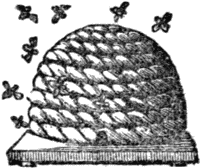
[87]
Use finely powdered colours, and mix them to the consistence of cream, with the following medium:—Mix the white of an egg with 2 oz. of pure distilled vinegar; put them into a bottle and shake them well together whenever you are about to mix any colours with it: or mix the colours with parchment size warmed; use while warm: or mix them with a weak solution of gum arabic; and, in either case, varnish them with a quick drying pale varnish. Oil colours will not do for painting this kind of materials: any of the above mediums, properly prepared, will answer well. Gilding may be interspersed with brilliant effect.
[88]
The quickest mode of staining the Ornamental Leather Work is as follows:—Procure a bottle of Revell’s Chymical Oak Colour Stain. This preparation will not soil the hands, or the finest linen or woollen fabrics; will not stain wood or any other substance than the leather to which it is applied, to which it imparts the perfect appearance of old oak without any gloss, at the same time hardening the leather without injuring it.
[89]
Having your leaves, &c., cut out and dried, pour some of the contents of this bottle into a saucer, and apply it copiously with a camel’s hair brush, all over the leaves, back and front, particularly the edges; bend them while damp as you wish them to appear upon the finished work, then dry them rather quickly at a moderate distance from the fire, or in a current of air; when dry they are ready for use.
The leaves, &c., can be attached to any form of work, and it is completed. When the entire work is complete, it can be varnished at pleasure, as follows:—Procure a bottle of Revell’s Oak Spirit Stain, and give the entire work an even coat of it; it dries in a few minutes, and has the appearance of polished oak.
[90]
If all the work is to be left dull, give the frame or bracket, &c., a coat of Oak Spirit Stain, which dries in dull if put upon new wood, not prepared in any manner. To prepare wooden frames, &c., so that the Oak Spirit Stain shall assume a polished surface, it is necessary to size the frame well and leave it to dry; when dry, give it one or more coats of Oak Spirit Stain.
Those who prefer making the Oak Spirit Stain, can do so by referring to the receipt in this book; it is made with little trouble, and is composed principally of Australian Red Gum; a new article to most of our readers; and, although many druggists, &c., have procured it when they have received orders for it, we are sorry to say, in several instances, they have said there was no article of that description; or else have substituted a[91] different kind of gum, perfectly worthless for this purpose; consequently, disappointment has ensued; and in order to protect the public from being imposed upon, and ourselves the disgrace of publishing anything not practicable, we are obliged, in self-defence, to state how we came to use it.
In the month of January, 1852, the publisher was applied to for a varnish stain that would dry quickly, and at the same time be the colour required: he was making experiments for this purpose, when, taking up the Times newspaper of Friday, January 23rd, he found, under the heading of Society of Arts, an epitome of Professor Edward Solly’s lecture, at the above Society on the previous Wednesday, on vegetable substances used in the Arts, &c. Allusions were made to a fine red gum from New South Wales: he procured the lecture, and then, after a little trouble, obtained samples; they were tested, and one was found to answer, and he has now in stock several tons of the proper kind for making the stain, and can supply it in any quantity.
[92]
We will now conclude by directing the student to an attentive observance of nature: we have avoided, as far as possible, technical terms; where they are used the illustrations will, in most cases, explain them. The study of this mode of decoration has often led those who had not before observed the varied beauties of the floral world to do so with the greatest pleasure and the happiest results.

[93]
Requires no preparation, sets almost immediately, will resist wet, violence, time, and climate; adheres to any surface or material; cements china, marble, wood, paper, leather, &c.; is useful to shipbuilders, carpenters, bookbinders, pianoforte, brush, and toy makers; and is so easy of application, that ladies and gentlemen may mend their own china, ornaments, toys, veneers, mouldings, parasols, book-covers, and a hundred other little articles, with the greatest ease and certainty.
[94]
[97]
Punctuation has been standardised.
The following inconsistencies were normalised:
The following additional original typos were repaired (the first line is the original text, the second the passage as currently stands):
End of the Project Gutenberg EBook of A Complete Guide to the Ornamental
Leather Work, by James Revell
*** END OF THIS PROJECT GUTENBERG EBOOK GUIDE TO ORNAMENTAL LEATHERWORK ***
***** This file should be named 41927-h.htm or 41927-h.zip *****
This and all associated files of various formats will be found in:
http://www.gutenberg.org/4/1/9/2/41927/
Produced by Chris Curnow, Rosanna Murphy and the Online
Distributed Proofreading Team at http://www.pgdp.net (This
file was produced from images generously made available
by The Internet Archive)
Updated editions will replace the previous one--the old editions
will be renamed.
Creating the works from public domain print editions means that no
one owns a United States copyright in these works, so the Foundation
(and you!) can copy and distribute it in the United States without
permission and without paying copyright royalties. Special rules,
set forth in the General Terms of Use part of this license, apply to
copying and distributing Project Gutenberg-tm electronic works to
protect the PROJECT GUTENBERG-tm concept and trademark. Project
Gutenberg is a registered trademark, and may not be used if you
charge for the eBooks, unless you receive specific permission. If you
do not charge anything for copies of this eBook, complying with the
rules is very easy. You may use this eBook for nearly any purpose
such as creation of derivative works, reports, performances and
research. They may be modified and printed and given away--you may do
practically ANYTHING with public domain eBooks. Redistribution is
subject to the trademark license, especially commercial
redistribution.
*** START: FULL LICENSE ***
THE FULL PROJECT GUTENBERG LICENSE
PLEASE READ THIS BEFORE YOU DISTRIBUTE OR USE THIS WORK
To protect the Project Gutenberg-tm mission of promoting the free
distribution of electronic works, by using or distributing this work
(or any other work associated in any way with the phrase "Project
Gutenberg"), you agree to comply with all the terms of the Full Project
Gutenberg-tm License available with this file or online at
www.gutenberg.org/license.
Section 1. General Terms of Use and Redistributing Project Gutenberg-tm
electronic works
1.A. By reading or using any part of this Project Gutenberg-tm
electronic work, you indicate that you have read, understand, agree to
and accept all the terms of this license and intellectual property
(trademark/copyright) agreement. If you do not agree to abide by all
the terms of this agreement, you must cease using and return or destroy
all copies of Project Gutenberg-tm electronic works in your possession.
If you paid a fee for obtaining a copy of or access to a Project
Gutenberg-tm electronic work and you do not agree to be bound by the
terms of this agreement, you may obtain a refund from the person or
entity to whom you paid the fee as set forth in paragraph 1.E.8.
1.B. "Project Gutenberg" is a registered trademark. It may only be
used on or associated in any way with an electronic work by people who
agree to be bound by the terms of this agreement. There are a few
things that you can do with most Project Gutenberg-tm electronic works
even without complying with the full terms of this agreement. See
paragraph 1.C below. There are a lot of things you can do with Project
Gutenberg-tm electronic works if you follow the terms of this agreement
and help preserve free future access to Project Gutenberg-tm electronic
works. See paragraph 1.E below.
1.C. The Project Gutenberg Literary Archive Foundation ("the Foundation"
or PGLAF), owns a compilation copyright in the collection of Project
Gutenberg-tm electronic works. Nearly all the individual works in the
collection are in the public domain in the United States. If an
individual work is in the public domain in the United States and you are
located in the United States, we do not claim a right to prevent you from
copying, distributing, performing, displaying or creating derivative
works based on the work as long as all references to Project Gutenberg
are removed. Of course, we hope that you will support the Project
Gutenberg-tm mission of promoting free access to electronic works by
freely sharing Project Gutenberg-tm works in compliance with the terms of
this agreement for keeping the Project Gutenberg-tm name associated with
the work. You can easily comply with the terms of this agreement by
keeping this work in the same format with its attached full Project
Gutenberg-tm License when you share it without charge with others.
1.D. The copyright laws of the place where you are located also govern
what you can do with this work. Copyright laws in most countries are in
a constant state of change. If you are outside the United States, check
the laws of your country in addition to the terms of this agreement
before downloading, copying, displaying, performing, distributing or
creating derivative works based on this work or any other Project
Gutenberg-tm work. The Foundation makes no representations concerning
the copyright status of any work in any country outside the United
States.
1.E. Unless you have removed all references to Project Gutenberg:
1.E.1. The following sentence, with active links to, or other immediate
access to, the full Project Gutenberg-tm License must appear prominently
whenever any copy of a Project Gutenberg-tm work (any work on which the
phrase "Project Gutenberg" appears, or with which the phrase "Project
Gutenberg" is associated) is accessed, displayed, performed, viewed,
copied or distributed:
This eBook is for the use of anyone anywhere at no cost and with
almost no restrictions whatsoever. You may copy it, give it away or
re-use it under the terms of the Project Gutenberg License included
with this eBook or online at www.gutenberg.org
1.E.2. If an individual Project Gutenberg-tm electronic work is derived
from the public domain (does not contain a notice indicating that it is
posted with permission of the copyright holder), the work can be copied
and distributed to anyone in the United States without paying any fees
or charges. If you are redistributing or providing access to a work
with the phrase "Project Gutenberg" associated with or appearing on the
work, you must comply either with the requirements of paragraphs 1.E.1
through 1.E.7 or obtain permission for the use of the work and the
Project Gutenberg-tm trademark as set forth in paragraphs 1.E.8 or
1.E.9.
1.E.3. If an individual Project Gutenberg-tm electronic work is posted
with the permission of the copyright holder, your use and distribution
must comply with both paragraphs 1.E.1 through 1.E.7 and any additional
terms imposed by the copyright holder. Additional terms will be linked
to the Project Gutenberg-tm License for all works posted with the
permission of the copyright holder found at the beginning of this work.
1.E.4. Do not unlink or detach or remove the full Project Gutenberg-tm
License terms from this work, or any files containing a part of this
work or any other work associated with Project Gutenberg-tm.
1.E.5. Do not copy, display, perform, distribute or redistribute this
electronic work, or any part of this electronic work, without
prominently displaying the sentence set forth in paragraph 1.E.1 with
active links or immediate access to the full terms of the Project
Gutenberg-tm License.
1.E.6. You may convert to and distribute this work in any binary,
compressed, marked up, nonproprietary or proprietary form, including any
word processing or hypertext form. However, if you provide access to or
distribute copies of a Project Gutenberg-tm work in a format other than
"Plain Vanilla ASCII" or other format used in the official version
posted on the official Project Gutenberg-tm web site (www.gutenberg.org),
you must, at no additional cost, fee or expense to the user, provide a
copy, a means of exporting a copy, or a means of obtaining a copy upon
request, of the work in its original "Plain Vanilla ASCII" or other
form. Any alternate format must include the full Project Gutenberg-tm
License as specified in paragraph 1.E.1.
1.E.7. Do not charge a fee for access to, viewing, displaying,
performing, copying or distributing any Project Gutenberg-tm works
unless you comply with paragraph 1.E.8 or 1.E.9.
1.E.8. You may charge a reasonable fee for copies of or providing
access to or distributing Project Gutenberg-tm electronic works provided
that
- You pay a royalty fee of 20% of the gross profits you derive from
the use of Project Gutenberg-tm works calculated using the method
you already use to calculate your applicable taxes. The fee is
owed to the owner of the Project Gutenberg-tm trademark, but he
has agreed to donate royalties under this paragraph to the
Project Gutenberg Literary Archive Foundation. Royalty payments
must be paid within 60 days following each date on which you
prepare (or are legally required to prepare) your periodic tax
returns. Royalty payments should be clearly marked as such and
sent to the Project Gutenberg Literary Archive Foundation at the
address specified in Section 4, "Information about donations to
the Project Gutenberg Literary Archive Foundation."
- You provide a full refund of any money paid by a user who notifies
you in writing (or by e-mail) within 30 days of receipt that s/he
does not agree to the terms of the full Project Gutenberg-tm
License. You must require such a user to return or
destroy all copies of the works possessed in a physical medium
and discontinue all use of and all access to other copies of
Project Gutenberg-tm works.
- You provide, in accordance with paragraph 1.F.3, a full refund of any
money paid for a work or a replacement copy, if a defect in the
electronic work is discovered and reported to you within 90 days
of receipt of the work.
- You comply with all other terms of this agreement for free
distribution of Project Gutenberg-tm works.
1.E.9. If you wish to charge a fee or distribute a Project Gutenberg-tm
electronic work or group of works on different terms than are set
forth in this agreement, you must obtain permission in writing from
both the Project Gutenberg Literary Archive Foundation and Michael
Hart, the owner of the Project Gutenberg-tm trademark. Contact the
Foundation as set forth in Section 3 below.
1.F.
1.F.1. Project Gutenberg volunteers and employees expend considerable
effort to identify, do copyright research on, transcribe and proofread
public domain works in creating the Project Gutenberg-tm
collection. Despite these efforts, Project Gutenberg-tm electronic
works, and the medium on which they may be stored, may contain
"Defects," such as, but not limited to, incomplete, inaccurate or
corrupt data, transcription errors, a copyright or other intellectual
property infringement, a defective or damaged disk or other medium, a
computer virus, or computer codes that damage or cannot be read by
your equipment.
1.F.2. LIMITED WARRANTY, DISCLAIMER OF DAMAGES - Except for the "Right
of Replacement or Refund" described in paragraph 1.F.3, the Project
Gutenberg Literary Archive Foundation, the owner of the Project
Gutenberg-tm trademark, and any other party distributing a Project
Gutenberg-tm electronic work under this agreement, disclaim all
liability to you for damages, costs and expenses, including legal
fees. YOU AGREE THAT YOU HAVE NO REMEDIES FOR NEGLIGENCE, STRICT
LIABILITY, BREACH OF WARRANTY OR BREACH OF CONTRACT EXCEPT THOSE
PROVIDED IN PARAGRAPH 1.F.3. YOU AGREE THAT THE FOUNDATION, THE
TRADEMARK OWNER, AND ANY DISTRIBUTOR UNDER THIS AGREEMENT WILL NOT BE
LIABLE TO YOU FOR ACTUAL, DIRECT, INDIRECT, CONSEQUENTIAL, PUNITIVE OR
INCIDENTAL DAMAGES EVEN IF YOU GIVE NOTICE OF THE POSSIBILITY OF SUCH
DAMAGE.
1.F.3. LIMITED RIGHT OF REPLACEMENT OR REFUND - If you discover a
defect in this electronic work within 90 days of receiving it, you can
receive a refund of the money (if any) you paid for it by sending a
written explanation to the person you received the work from. If you
received the work on a physical medium, you must return the medium with
your written explanation. The person or entity that provided you with
the defective work may elect to provide a replacement copy in lieu of a
refund. If you received the work electronically, the person or entity
providing it to you may choose to give you a second opportunity to
receive the work electronically in lieu of a refund. If the second copy
is also defective, you may demand a refund in writing without further
opportunities to fix the problem.
1.F.4. Except for the limited right of replacement or refund set forth
in paragraph 1.F.3, this work is provided to you 'AS-IS', WITH NO OTHER
WARRANTIES OF ANY KIND, EXPRESS OR IMPLIED, INCLUDING BUT NOT LIMITED TO
WARRANTIES OF MERCHANTABILITY OR FITNESS FOR ANY PURPOSE.
1.F.5. Some states do not allow disclaimers of certain implied
warranties or the exclusion or limitation of certain types of damages.
If any disclaimer or limitation set forth in this agreement violates the
law of the state applicable to this agreement, the agreement shall be
interpreted to make the maximum disclaimer or limitation permitted by
the applicable state law. The invalidity or unenforceability of any
provision of this agreement shall not void the remaining provisions.
1.F.6. INDEMNITY - You agree to indemnify and hold the Foundation, the
trademark owner, any agent or employee of the Foundation, anyone
providing copies of Project Gutenberg-tm electronic works in accordance
with this agreement, and any volunteers associated with the production,
promotion and distribution of Project Gutenberg-tm electronic works,
harmless from all liability, costs and expenses, including legal fees,
that arise directly or indirectly from any of the following which you do
or cause to occur: (a) distribution of this or any Project Gutenberg-tm
work, (b) alteration, modification, or additions or deletions to any
Project Gutenberg-tm work, and (c) any Defect you cause.
Section 2. Information about the Mission of Project Gutenberg-tm
Project Gutenberg-tm is synonymous with the free distribution of
electronic works in formats readable by the widest variety of computers
including obsolete, old, middle-aged and new computers. It exists
because of the efforts of hundreds of volunteers and donations from
people in all walks of life.
Volunteers and financial support to provide volunteers with the
assistance they need are critical to reaching Project Gutenberg-tm's
goals and ensuring that the Project Gutenberg-tm collection will
remain freely available for generations to come. In 2001, the Project
Gutenberg Literary Archive Foundation was created to provide a secure
and permanent future for Project Gutenberg-tm and future generations.
To learn more about the Project Gutenberg Literary Archive Foundation
and how your efforts and donations can help, see Sections 3 and 4
and the Foundation information page at www.gutenberg.org
Section 3. Information about the Project Gutenberg Literary Archive
Foundation
The Project Gutenberg Literary Archive Foundation is a non profit
501(c)(3) educational corporation organized under the laws of the
state of Mississippi and granted tax exempt status by the Internal
Revenue Service. The Foundation's EIN or federal tax identification
number is 64-6221541. Contributions to the Project Gutenberg
Literary Archive Foundation are tax deductible to the full extent
permitted by U.S. federal laws and your state's laws.
The Foundation's principal office is located at 4557 Melan Dr. S.
Fairbanks, AK, 99712., but its volunteers and employees are scattered
throughout numerous locations. Its business office is located at 809
North 1500 West, Salt Lake City, UT 84116, (801) 596-1887. Email
contact links and up to date contact information can be found at the
Foundation's web site and official page at www.gutenberg.org/contact
For additional contact information:
Dr. Gregory B. Newby
Chief Executive and Director
[email protected]
Section 4. Information about Donations to the Project Gutenberg
Literary Archive Foundation
Project Gutenberg-tm depends upon and cannot survive without wide
spread public support and donations to carry out its mission of
increasing the number of public domain and licensed works that can be
freely distributed in machine readable form accessible by the widest
array of equipment including outdated equipment. Many small donations
($1 to $5,000) are particularly important to maintaining tax exempt
status with the IRS.
The Foundation is committed to complying with the laws regulating
charities and charitable donations in all 50 states of the United
States. Compliance requirements are not uniform and it takes a
considerable effort, much paperwork and many fees to meet and keep up
with these requirements. We do not solicit donations in locations
where we have not received written confirmation of compliance. To
SEND DONATIONS or determine the status of compliance for any
particular state visit www.gutenberg.org/donate
While we cannot and do not solicit contributions from states where we
have not met the solicitation requirements, we know of no prohibition
against accepting unsolicited donations from donors in such states who
approach us with offers to donate.
International donations are gratefully accepted, but we cannot make
any statements concerning tax treatment of donations received from
outside the United States. U.S. laws alone swamp our small staff.
Please check the Project Gutenberg Web pages for current donation
methods and addresses. Donations are accepted in a number of other
ways including checks, online payments and credit card donations.
To donate, please visit: www.gutenberg.org/donate
Section 5. General Information About Project Gutenberg-tm electronic
works.
Professor Michael S. Hart was the originator of the Project Gutenberg-tm
concept of a library of electronic works that could be freely shared
with anyone. For forty years, he produced and distributed Project
Gutenberg-tm eBooks with only a loose network of volunteer support.
Project Gutenberg-tm eBooks are often created from several printed
editions, all of which are confirmed as Public Domain in the U.S.
unless a copyright notice is included. Thus, we do not necessarily
keep eBooks in compliance with any particular paper edition.
Most people start at our Web site which has the main PG search facility:
www.gutenberg.org
This Web site includes information about Project Gutenberg-tm,
including how to make donations to the Project Gutenberg Literary
Archive Foundation, how to help produce our new eBooks, and how to
subscribe to our email newsletter to hear about new eBooks.